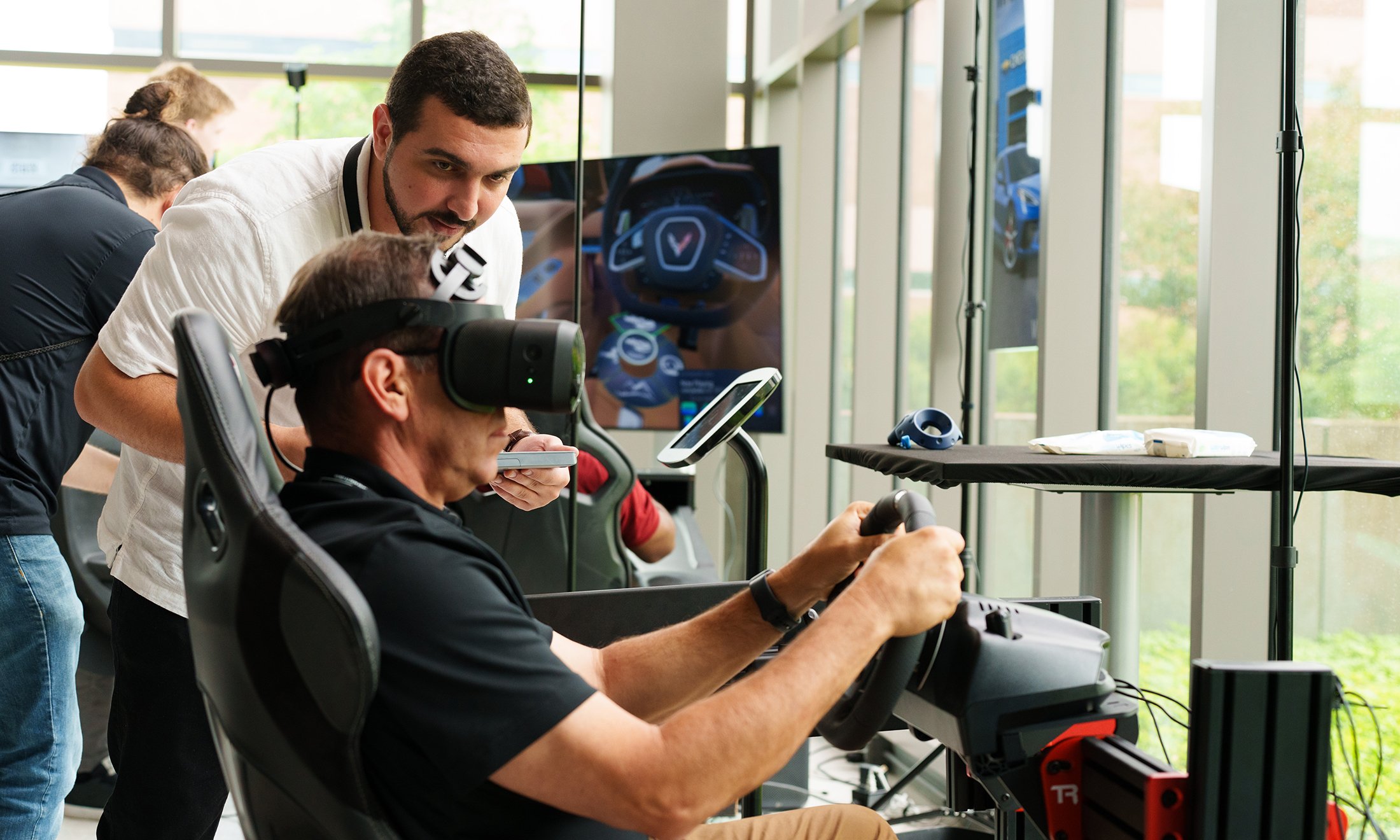Catalyst For Innovation
OU’s Augmented Reality Center demonstrates the power of collaboration

Photo Credit: Robert Hall
It was a day some of the most inventive, forward-thinking minds of the region had been eagerly anticipating. On Friday, June 23, a host of industry professionals and community leaders from across southeast Michigan convened to celebrate the grand opening of Oakland University’s Augmented Reality Center (ARC).
ARC is an ambitious endeavor by OU’s School of Engineering and Computer Science dedicated to teaching people how to work with groundbreaking digital immersive technologies. Supported by over a dozen corporate partners, ARC’s mission is to foster an educational environment where students, faculty and industry professionals work together to create new applications for manufacturing and other fields.
Two principal forms of immersive technology are augmented reality (AR) and virtual reality (VR). Both blend a person’s physical environment with the digital world and are experienced through wearable headsets and glasses or other devices such as smartphones and tablets.
“VR completely immerses you in a simulated environment and blocks out the ‘real’ world,” says Khalid Mirza, Ph.D., ARC's founding director. “With AR, however, you can still see the
room and everything else around you. But it’s augmented with additional graphics and digitized information in the space. Both can be useful for employee training, product design, machine maintenance and more.”
A unique aspect behind ARC’s educational initiative is that it recognizes both the technical and creative skillsets needed to work in the area. The College for Creative Studies, an art and design school in Detroit, is a key collaborator in ARC. Together, the two schools are teaming up to empower engineering and art students to learn from one another. “An AR or VR application can be engineered and programmed very well, but it also has to be visually compelling and engage the user effectively,” says Mirza. “That’s why the combination of engineering and design is so important.”
The highlight of the grand opening event was the public unveiling of the ARC Lab. Here, anyone is welcome to come and try out the latest gadgets and experience their potential and power. The lab is located on the second floor of OU’s Engineering Center and offers public visiting hours on selected weekdays.
"By collaborating with each other, we are not only helping create solutions for companies, we’re building their future workforce at the same time."
While immersive technologies are entrenched tools of the gaming and entertainment industries, their use in manufacturing is now rapidly expanding. Ed Volcic, vice president of Industry Management at KUKA Robotics, explains one application. “Augmented reality is being used to help visualize technical components within the robotics environment that normally you have in your mind or on a laptop. In fact, a demonstration of how digitized information can be superimposed over an actual robot is one of the experiences offered in the ARC Lab.” Volcic adds, “Being able to see [data] right in front of you in an automation cell brings a ton of value. It really helps you understand what’s going on.”
Heiko Wenczel, director for unreal engine, human machine interface and automotive at Epic Games says, “We’re in the middle of a revolution, a real-time revolution, where the interaction with tools, especially game engines in the industrial space, is becoming more prevalent.”
Game engines are software platforms that enable developers to easily create their applications in interactive and extremely realistic 3D digital environments. “A lot of companies are recognizing that using these tools is going to be a competitive advantage over everyone else that’s not using them,” Wenczel advises.
But, knowing how to use these tools can be challenging for companies since the technology is so new and few employees currently have the skills to work with them. “That’s how ARC can help,” Mirza explains. “We bring together the companies, the engineering students, the design students and the faculty who are interested in this technology. By collaborating with each other, we are not only helping create solutions for companies, we’re building their future workforce at the same time.”
Volcic echoes the value of these collaborative efforts, especially among ARC’s partner companies. “All of us work in our own unique industries but there’s a ton of overlap. We’re all using very similar technologies. Bringing those different viewpoints together gives you the opportunity to come up with new ideas and things that you never would have imagined or thought of on your own."
For more information about the Augmented Reality Center and the lab’s public hours, please visit:
To learn about partnership opportunities and benefits of becoming an ARC corporate partner, contact Anthony Gallina at [email protected].
WITH GRATITUDE FOR ARC’S FOUNDING PARTNERS
ABB, Inc.
AM General
Continental
Epic Games
General Motors
Granstudio
Hirotec America
KUKA Robotics
Magna International
MAHLE
NVIDIA
RAVE Computer
Siemens
US Army/GVSC
Vectorform


 January 11, 2024
January 11, 2024 By Deborah Kiefer
By Deborah Kiefer

